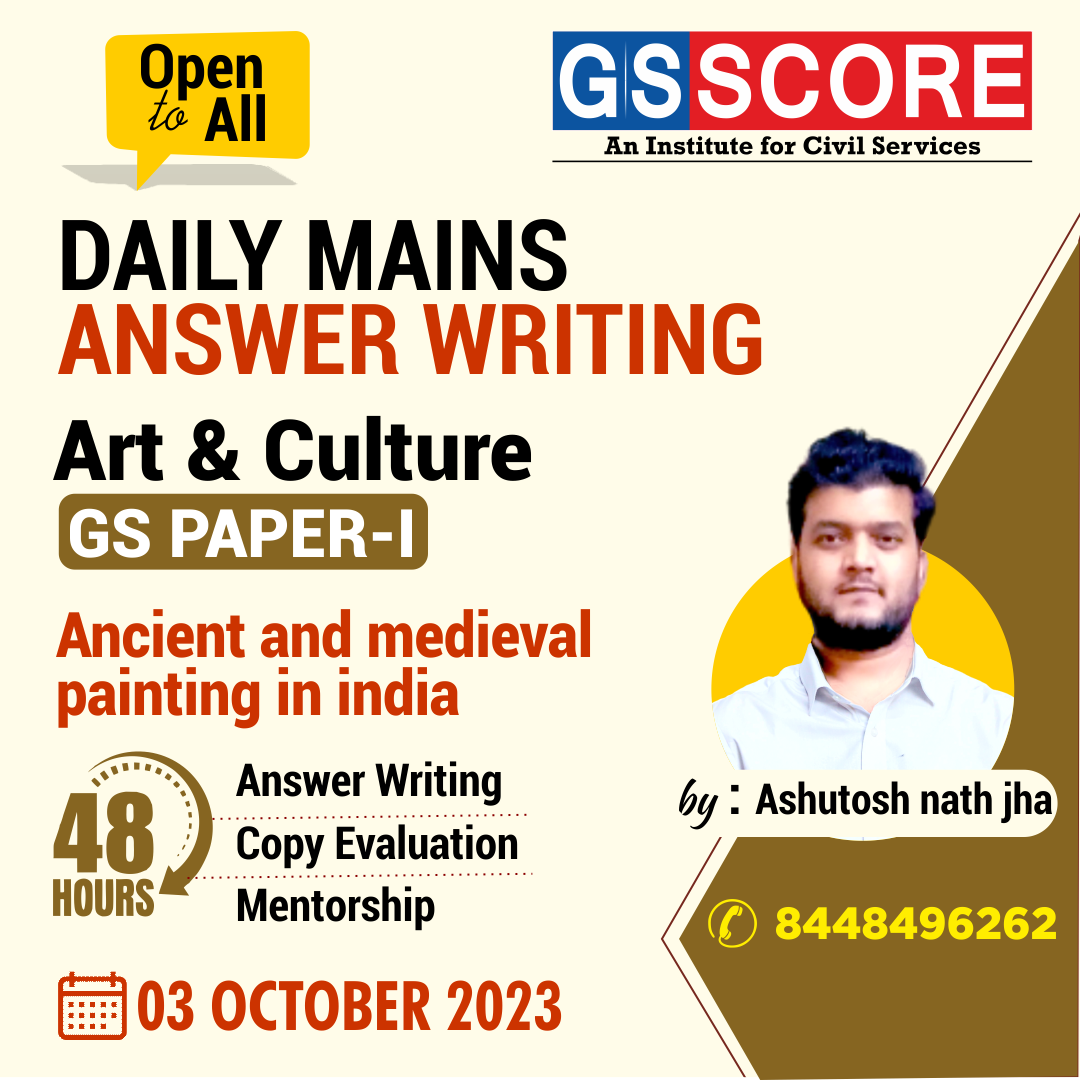


Instruction:
- There will be 2 questions carrying the First Question is-10 marks Write your answers in 150 words and the Second Question is-15 marks Write your answers in 250 words.
- Any page left blank in the answer-book must be crossed out clearly.
- Evaluated Copy will be re-uploaded on the same thread after 2 days of uploading the copy.
- Discussion of the question and one to one answer improvement session of evaluated copies will be conducted through Google Meet with concerned faculty. You will be informed via mail or SMS for the discussion.
Question #1. In the context of ancient Indian art, Discuss the evolution and significance of painting styles and themes from the early rock paintings of Bhimbetka to the frescoes of Ajanta and Ellora. 10 marks (150 words)
Question #2. Discuss the thematic differences, cultural influences, and socio-political contexts that shaped the imperial and regional painting during medieval India. 15 marks (250 words)
(Examiner will pay special attention to the candidate's grasp of his/her material, its relevance to the subject chosen, and to his/ her ability to think constructively and to present his/her ideas concisely, logically and effectively).
STEPS & INSTRUCTIONS for uploading the answers
Step 1 - The Question for the day is provided below these instructions. It will be available at 7:00 AM.
Step 2 - Uploading of Answers : Write the answer in A4 Sheet leaving proper margins for comments and feedback and upload the PDF in MY ACCOUNT section. Click on the option of SUBMIT COPY to upload the PDF.
Step 3 - Deadline for Uploading Answers: The students shall upload their answers by 7:00 PM in the evening same day. The first 50 copies will be evaluated.
Step 4 - Feedback : Mentors will give their feedback for the answers uploaded. For more personalised feedback, join our telegram channel by clicking on the link https://t.me/mains_answer_writing_cse . A one-to-one session will be conducted with the faculty after copy evaluation in 72 Hrs.
Model Answer
Question #1. In the context of ancient Indian art, Discuss the evolution and significance of painting styles and themes from the early rock paintings of Bhimbetka to the frescoes of Ajanta and Ellora. 10 marks (150 words)
|
Approch:
|
Hints
Certainly, the evolution of painting styles and themes in ancient India, from the early rock paintings of Bhimbetka to the frescoes of Ajanta and Ellora, is a fascinating journey marked by profound cultural, religious, and historical influences.
Bhimbetka Rock Paintings:10,000 BCE - 500 CE)
Time Period: These paintings, found in the rock shelters of Bhimbetka, Madhya Pradesh, date back to as early as 30,000 years ago.
Style and Themes: The Bhimbetka paintings predominantly feature scenes from everyday life, showcasing hunting, dancing, and communal activities. These are executed in a rudimentary, linear style.
Significance: These paintings provide invaluable insights into the lives and beliefs of India's ancient inhabitants. They reflect the importance of nature, animals, and communal bonds in their existence.
Ajanta Frescoes:(2nd century BCE - 5th century CE)
Time Period: The Ajanta Caves were excavated over a period of several centuries, with the earliest paintings dating back to the 2nd century BCE and the latest to around the 7th century CE.
Style and Themes: The frescoes at Ajanta showcase an evolution in artistic technique, with later paintings being more intricate and detailed. The themes are predominantly religious, featuring scenes from the life of Buddha, Jataka tales, and various deities.
Significance: These frescoes not only highlight the rich artistic tradition of ancient India but also serve as a visual record of the spread and development of Buddhism in the region. They are a testament to the flourishing Gupta period, known as a golden age of Indian art.
Ellora Frescoes: 6th - 10th century CE):
Time Period: The Ellora Caves, like Ajanta, span several centuries, with work commencing around the 6th century CE and continuing into the 9th century CE.
Style and Themes: The frescoes at Ellora are characterized by a blend of Hindu, Jain, and Buddhist themes, reflecting the religious diversity of the time. They are often more stylized and detailed than earlier works.
Significance: These frescoes mirror the religious syncretism of the medieval period, where different faiths coexisted and influenced each other. They offer a glimpse into the artistic expressions of these diverse belief systems.
Cultural, Religious, and Historical Influences:
Cultural: The art of each era was deeply influenced by the prevailing cultural norms and values, reflecting the social fabric of the time.
Religious: The dominant religion in each period played a pivotal role in shaping the themes of the paintings. Buddhism at Ajanta and the blend of Hindu, Jain, and Buddhist influences at Ellora are prime examples.
Historical: Political dynasties and patronage greatly impacted the development of these painting styles. The Guptas' support for Ajanta, for instance, was crucial in its flourishing.
The evolution of painting styles and themes in ancient India, from Bhimbetka to Ajanta and Ellora, reveals not only artistic progression but also the dynamic interplay of culture, religion, and history. These artworks are not mere relics of the past; they are windows into the multifaceted tapestry of India's ancient civilizations.
Question #2. Discuss the thematic differences, cultural influences, and socio-political contexts that shaped the imperial and regional painting during medieval India. 15 marks (250 words)
Hints
In medieval India, Imperial and Regional paintings diverged in themes, cultural influences, and socio-political contexts, reflecting the vibrant diversity of the subcontinent's artistic heritage.Imperial Schools of Painting:
Thematic Differences:
Imperial paintings, exemplified by the Mughal tradition, often revolved around the themes of royal portraits, court life, and historical events.
These paintings showcased meticulous detail, realistic portrayal of subjects, and a focus on individual personalities, particularly emperors and their courts.
Cultural Influences:
Mughal paintings were heavily influenced by Persian art styles, reflecting the Persian cultural heritage of the Mughal rulers.
Persian miniature painting techniques and Persian literary themes found their way into Mughal art.
Socio-Political Contexts:
Mughal emperors like Akbar and Jahangir were great patrons of the arts. They commissioned artists to create exquisite manuscripts, often illustrating the emperor's life and achievements.
The Imperial Mughal paintings served not only as art but also as a means of projecting the power and grandeur of the Mughal Empire.
Regional Painting:
Thematic Differences:
Regional paintings in medieval India were more diverse in themes, reflecting the cultural and religious diversity of different regions.
These paintings often depicted themes from Hindu epics, local legends, mythology, and everyday life.
One example of Pala school of painting which belongs to the 8-9th ce, represent Buddhist symbols, yantras etc. It was also influenced by the vajrayana sect of Buddhism. Further the Buddhist miniatures portray deities like Prajnaparamita who was the mother of all Buddha.
Deccani school- when compared to the Mughals, they exceed in the brilliance in terms of their use of colour, sophistication and composition. Besides there are some illustrated chronicles like Tuzuk-i- Asafiya.
Cultural Influences:
Regional paintings were deeply rooted in local traditions and religious beliefs. For instance, Rajput painting drew inspiration from Hindu texts and themes.
Different regions, like Rajasthan and Kangra, developed their unique styles and iconography.
Pahari painting - grouped in to two: Dogra and Basholi and Kangra school. Basholi reflect the bold and intense use of colour and designs whereas kangra ones are delicate and reflects lyrical composition.
Socio-Political Contexts:
Regional rulers and nobility, such as the Rajput kings, played a significant role in patronizing regional painting traditions.
Further the sophistication in art forms achieved excellence due to the political patronage .
These paintings often depicted the valor of local heroes, courtly life, and religious devotion, reinforcing the regional identity.
Regional painting thrived in the context of decentralized rule, with different princely states and kingdoms fostering their unique artistic traditions.
Patronage: Local rulers and nobility played a crucial role in patronizing regional painters, allowing for the development of distinct regional schools of art.
Examples:
An example of Imperial painting is the "Akbar Nama," a manuscript illustrating the life and reign of Emperor Akbar.
In contrast, the Rajput painting known as the "Ragamala" series beautifully portrays various musical modes and moods through art.
The thematic differences between Imperial and Regional paintings highlight the influence of culture and socio-political contexts. While Imperial paintings focused on centralized power and Persian-inspired themes, Regional paintings showcased a rich tapestry of local beliefs and identities. The cultural influences from Persia and Hinduism shaped these two distinct traditions. Socio-politically, Imperial painting served the empire's grandeur, while Regional painting reflected the patronage of local rulers and the diversity of Indian society.
Imperial and Regional paintings in medieval India represent the rich artistic and cultural heritage of the subcontinent, shaped by distinct themes, influences, and contexts. These traditions continue to provide valuable insights into the historical and cultural tapestry of India.

